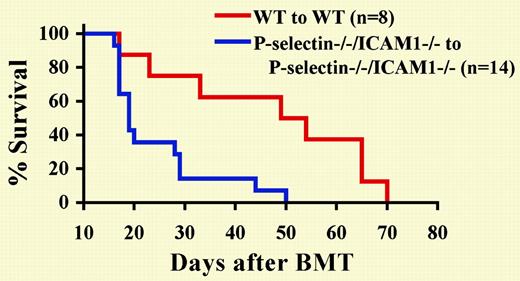Comment on Pelletier et al, page 2163
Pelletier and colleagues report that the lack of the adhesion molecules P-selectin and ICAM-1 accelerates the development of BCR/ABL-induced CML-like disease in mice. The data have important implications for understanding as well as treating CML.
Chronic myelogenous leukemia (CML) is characterized by high peripheral white blood cell (WBC) counts with granulocyte predominance and extramedullary hematopoiesis. Although the CML progenitor cells retain the ability to terminally differentiate during the chronic phase of CML, immature myeloid cells are abnormally expanded and leave bone marrow prematurely. It was postulated that, in addition to dysregulated cell proliferation and survival, altered adhesion to stromal cells and the extracellular matrix might be responsible for the abnormal circulation and proliferation of CML cells. In vitro, it was shown that CML progenitor cells from patients exhibited decreased adhesion to bone marrow stroma or fibronectin and are not subjected to normal contact inhibition of proliferation (reviewed in Verfaillie et al1 ). However, the in vivo proof of this hypothesis is lacking. Moreover, in contrast to the primary cells from CML patients, it has been found that expression of the BCR/ABL fusion gene, a product of the t(9;22)(q34;q11) translocation and hallmark of human CML, in hematopoietic cell lines increases instead of decreases cell adhesion to fibronectin (reviewed in Wertheim et al2 ). Interestingly, this activity of BCR/ABL is independent of the ABL tyrosine kinase activity, which is essential for BCR/ABL leukemogenesis.3 In addition, domains of BCR/ABL, such as the ABL actin-binding domain, that are necessary for the enhanced cell adhesion are not required for the induction of CML-like myeloproliferative disorder (MPD) by BCR/ABL in mice. These conflicting results in different cells suggest that the role of cell adhesion in the pathogenesis of CML may be complicated.FIG1
Lack of P-selectin and ICAM-1 accelerates the development of CML-like leukemia induced by BCR/ABL. See the complete figure in the article beginning on page 2163.
Lack of P-selectin and ICAM-1 accelerates the development of CML-like leukemia induced by BCR/ABL. See the complete figure in the article beginning on page 2163.
In this issue of Blood, Pelletier and colleagues add a new dimension to the role of cell adhesion in CML. They report that the lack of the adhesion molecules P-selectin and, to a lesser extent, intercellular adhesion molecule-1 (ICAM-1) accelerates the development of BCR/ABL-induced CML-like MPD, but not BCR/ABL-induced acute lymphoblastic leukemia (ALL), in a mouse bone marrow transduction and transplantation model. The accelerated disease development in the absence of P-selectin and ICAM-1 appears to be due to altered distribution of leukemic cells; fewer of these cells are in the bone marrow and more accumulate in the lungs, rather than increased proliferation of leukemic cells. Myeloid cell infiltration and extramedullary hematopoiesis in the lungs is a characteristic of the murine model for CML and is likely the major cause of death for the diseased mice. These results suggest that cell adhesion through P-selectin and ICAM-1 plays a suppressive role in the development of CML. This conclusion has the following implications. (1) Cell adhesion through molecules such as P-selectin and ICAM-1 and negative regulation from them remain, at least partially, in CML cells. However, this study does not rule out the possibility that CML cells may have already overcome some of the negative regulations from cell adhesion. (2) Since Pselectin and ICAM-1 are not essential for homing of normal hematopoietic cells to bone marrow, loss of P-selectin and ICAM-1 must collaborate with adhesion defects caused by BCR/ABL in reducing the retention of BCR/ABL-expressing myeloid cells in bone marrow. (3) Improving adhesion of CML cells, either enhancing normal cell adhesion or targeting BCR/ABL signaling pathways that disrupt cell adhesion, or both, may be a valuable strategy for CML therapy. Further studies are needed to demonstrate the relevance of the tumor suppression effects of P-selectin and ICAM-1 to human CML. In particular, development of pulmonary hemorrhage is a major difference between human CML, in which pulmonary manifestations are rare, and the murine model for CML. Current data could not rule out the possibility that increased accumulation of leukemic cells in the lungs in the absence of P-selectin and ICAM-1 may be due to certain experimental condition(s) of the model system. Nevertheless, this report raised an interesting possibility that normal cell adhesion may restrain CML.


